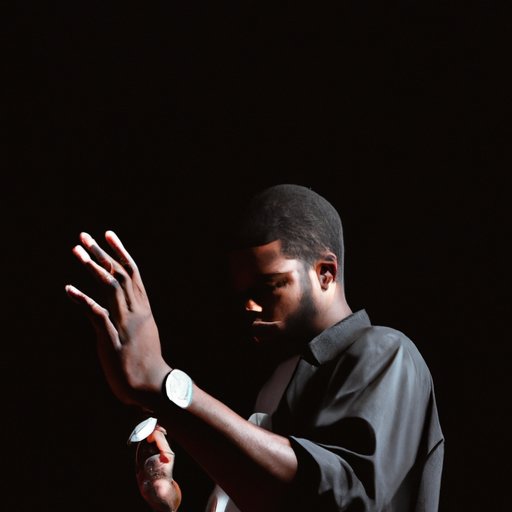
Introduction
Rapping is a form of musical expression that dates back to the early 1970s and has now become a global phenomenon. Often considered a blend of poetry and music, it involves rapid delivery of rhymes over beats. While it seems easy and effortless, mastering the art of rapping requires skill, practice, and hard work. In this article, we’ll break down the process of rapping into 7 manageable steps and offer tips and strategies to help you improve your rapping skills.
7 Steps to Mastering the Art of Rapping
Rapping involves a unique set of skills, such as wordplay, flow, and cadence. Here are the 7 steps we’ll be discussing in detail:
1. Understanding the Foundation of Rhythm
2. Building Your Vocabulary
3. Developing Your Flow
4. Working on Wordplay
5. Creating Hooks and Choruses
6. Recording and Practice
7. Networking and Collaboration
Step 1: Understanding the Foundation of Rhythm
Rhythm is the foundation of rapping. Getting the rhythm right can make or break a rap performance. To understand the rhythm, start by listening to different types of popular beats and try to count the beats. Once you’ve identified the beats, practice rapping over them by starting slowly and gradually increasing the speed. Repeat this process until you can comfortably rap with the beat.
Step 2: Building Your Vocabulary
The vocabulary of a rapper is important in conveying his or her message effectively. Start by reading more books, articles, and social media posts. Be on the lookout for interesting and unique words that you can use in your raps. You can also take inspiration from other rappers and their lyrics. Make a habit of jotting down new words weekly and practice using them in your raps.
Step 3: Developing Your Flow
The flow is one of the most important aspects of a rap performance. It refers to the rhythm, pace, and tone of your rap. Get into the habit of practicing different rap flows by listening to and studying raps from different artists. Pay attention to how they pace their words, pause, or break their flow.
Step 4: Working on Wordplay
Rap is all about wordplay. Your ability to create clever wordplay is important, as it will help you stand out among other rappers. Explore different types of wordplay such as metaphors, similes, alliteration, and rhyming. Try to incorporate them into your raps to make them more engaging and interesting.
Step 5: Creating Hooks and Choruses
Choruses and hooks can help keep your lyrics in the minds of your listeners. Create hooks and choruses that are catchy, memorable, and relevant. Use repetition to make them more memorable. The hook can also be used to emphasize or reinforce the main message of your rap.
Step 6: Recording and Practice
Recording yourself rapping can be an excellent way to practice and monitor your progress. Record your raps and listen back to them, analyze what can be improved, and keep practicing. With each rap, challenge yourself to incorporate a new concept, such as stronger wordplay or a more complicated flow.
Step 7: Networking and Collaboration
Collaborating with other artists is one of the best ways to grow as a rapper. Attend open mic events, rap battles, and competitions to meet other rappers. Collaborate with other artists by combining your skills, working on new beats, or producing joint albums.
Finding Inspiration for Your Raps
Finding inspiration is important for creating great rap. Inspiration can come from different sources such as personal experiences, current events, and other artists. Use your life experiences, stories, emotions, and observations, and turn them into lyrical masterpieces. Reading more books and watching movies or TV shows can also inspire you to create new themes or styles.
Tips for Writing Powerful Lyrics
Strong, meaningful lyrics are key to a great rap. Use your lyrics to convey your message effectively and engage your audience. A good rhythm, cleaver wordplay, and a unique flow will bring your lyrics to life. Create your own writing routine and set a goal for writing new lyrics each week.
Understanding Beats and Rhythm
Understanding beats and rhythm can help you create a great flow. Experiment with different types of beats, read sheet music and learn about the various rhythms used in music. Get to know the different drum sounds and sound kits used in constructing beats.
Developing Your Own Style and Sound
The distinctive sound of a rapper comes from a unique style and sound. Finding your own sound involves experimenting with different techniques and approaches, being true to yourself, and not trying to imitate other rappers. Practice a range of styles and find which one feels natural to you.
Performance Tips for the Aspiring Rapper
Live performance is important for a rapper as it helps to establish a personal style and interact with audiences. Engage the listeners by making eye contact, use body language, and express your emotions through your performance. Be confident and practice your stage presence and feel comfortable singing in front of a live audience.
Conclusion
Rapping is an art that requires patience, practice, and creativity. With the steps outlined above, you can create a blueprint for your own path and develop your own style and sound. Start by mastering the foundation of rhythm and building your vocabulary, practicing your flow, and working on your wordplay. Don’t forget to network, collaborate and perform live. With these skills and tips on how to rap, you’ll be on your way to becoming a successful rapper.





